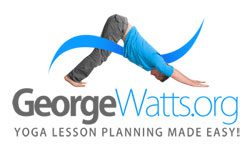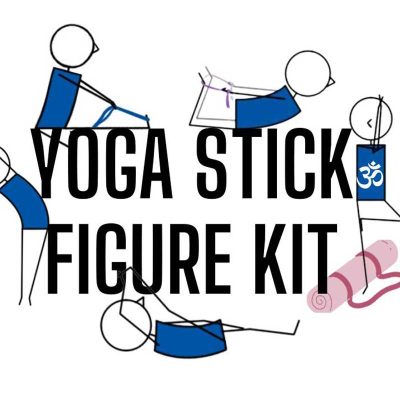One of my latest yoga lesson bundles is called the Triathlon Yoga Lesson Plan Bundle. To celebrate, I thought I’d share some of my research on what Yoga poses are good for triathletes. You can find my yoga for runners blog here.
Yoga For Triathletes: Cycling
While there are many Yoga poses that target specific muscles overworked on the bike, the TRAINING OF THE BREATH is essential to your practice. The physical areas of focus for cycling are ARMS, BUTTOCKS, CALVES, FEET, SPINE and THIGHS.
In an age of marginal gains, we are all striving for that extra 1%, and while nothing can compare to time spent in the saddle, more and more cyclists are now also turning to yoga to improve their performance. Yoga exercises will help increase your strength, power and ability on the road.
Yoga will help counteract any muscle stiffness that may come from riding and help build strength and flexibility in the arms, buttocks, calves, feet and thighs.
Cyclists need to focus on leg strength, which many poses in yoga target, but they also need to focus on flexibility and lower back strength. Cyclists spend most of their time bent forward over the handlebars, which leads to tight hip flexors. Many yoga poses target the hip flexors and lower back, helping to balance muscle strength and prevent injury. Yoga also keeps you focused on a deep and steady breath, forcing you to work aerobically.
Breathing exercises will also bring much-needed oxygen to the muscles which reduce the build-up of lactic acid. Training your muscles aerobically and learning how to control your breathing are two important aspects of training and racing for any triathlete.
The physical areas of focus for cyclists are:
- ARMS
- BUTTOCKS
- CALVES
- FEET
- SPINE
- THIGHS
Yogic breathing exercises will help increase stamina and bring much-needed oxygen to the muscles which reduces the build-up of lactic acid.
Recommended Yoga Poses For Cyclists
- Legs Up
- One Leg Kick
- Plough
- Rocker With Open Legs
- Rolling Back
- Swan Dive
Below is the “Legs Up” pose handout. You can download the other handouts when you get the Triathlon Yoga Lesson Plan Bundle.
Cycling The Yogic Way: A to Z Guide
Below are some Yogic tips that will REDUCE FATIGUE, DECREASE THE CHANCE OF INJURY, and turn a bike ride from a mental battle to a MEDITATION.
10-Minute Daily Yoga Practice
For most cyclists, a 90-minute yoga class that ends in a nap is not a realistic daily commitment. But there is one simple sequence that takes very little time and can be repeated to establish a daily practice easily. Commonly referred to as a Sun Salutation, this sequence is fundamental to all branches (styles) of yoga as it represents the basic, full-body opening.
Belly Breathing
The secret weapon in breathing efficiency is belly breathing – the ability to recruit your diaphragm to push as much air in and out of your lungs as possible. A lot of time spent sitting hunched in front of a TV or computer can make your diaphragm weaker and promotes shallow chest breathing. That’s why you will have to practice sending your breath to your belly to expand the abdomen and exercise the diaphragm muscle.
Body Awareness
One of the top-secret benefits of Yoga practice is becoming more aware of what your body “is” and “is not” capable of. This will help improve your performance and reduce the likelihood of injury.
Breathing Exercise: 3-3-3
Do this basic breathing exercise off the bike first, to get used to how proper belly breathing feels before you try it while riding. New research shows that if you’re able to get your breathing down to approximately 10 breaths per minute, you will notice the benefits (in your riding performance, and in your life because your default state will be one of calm and serenity. Doing this breathing exercise will help you get there. Practice it anywhere…at home, on the bus, or at work. The exercise is “exhale for three seconds, inhale for three seconds”. Here are some tips to get you started. Place hands on the sternum (top of abdomen) to feel your stomach as you slowly push it out with each inhale (imagine you’re inflating a balloon within your stomach), and slowly suck the stomach in with each exhale.
Breathing Exercise: Altitude Breath I
This breathing exercise simulates training at an altitude of 2,000 metres above sea level.
1) Walk at a normal pace. Exhale, hold your breath and walk 10 steps.
2) Breathe normally for 2-3 steps.
3) Exhale, hold your breath and walk 15 steps.
4) Repeat and increase the steps by 5 until you reach 50.
Breathing Exercise: Altitude Breath II
This breathing exercise simulates training at an altitude of 2,000 metres above sea level.
1) Ride at a moderate pace with a cadence of about 90 RPMs.
2) Inhale for 2 strokes, hold your breath for 2 strokes, and exhale for 4 strokes.
3) If this results in shallow breathing, adjust the “2,2,4” pattern to “4,4,8” or higher.
Breathing Exercise: Pedal Stroke Breath Counting
Being able to control your breathing on the bike, can turn a challenging mountain into a molehill. Counting your breaths to the rhythm of your pedal strokes can help bring your focus back to breathing. Settle into a cadence of 90-95 RPMs and breathe like this:
1) Inhale for 3 down-strokes, letting the air in naturally without force.
2) Exhale for 6 down-strokes, forcing air out with an audible “SSS”. Press belly muscles towards the spine on each exhale.
3) Change the number of pedal strokes based on terrain and lung capacity, but always assign more strokes to the exhale.
Breathing Exercise: Nose
A breath is one full inhalation and one full exhalation through the nose.
Five Percent Rule
Avoid doing too much too soon. A good rule is to not increase training by more than 5% at a time.
Flowing Movements
Holding poses is good for cycling, but most of your Yoga practice should be focused on “flowing movements” (moving from one pose to another without holding it for more than a few seconds). Working through a full range of movements will build muscle endurance.
Graceful Yoga
Practice each pose gracefully. Bouncing or forcing a yoga pose will cause muscles to tighten, and increase your risk of injury. Stretch in a slow, steady motion to the point of “mild discomfort.” If you are stretching to the point of pain, you have stretched too far. Respect your edge and be aware when your ego wants you to go beyond it, then tell your ego, “Nope. I respect my edge.”
Injury: Knees
The main causes of knee pain during cycling are overuse, weak muscles and improper bike fit. Having your saddle in the wrong position can also cause knee pain. Riding with your saddle too low or too far forward can make peddling more strenuous, leading to patellofemoral pain syndrome (PFPS), also known as ‘runner’s knee’.
Injury: Hand & Wrist Pain
Many cyclists will suffer to some degree from hand and wrist pain. Yoga will help.
Injury: Neck & Shoulder Pain
Many cyclists will suffer to some degree from neck and shoulder pain. Yoga will help. Neck and upper back pain is most often caused and exacerbated by riding position and technique. Riding in drop handlebars for long periods will not only increase the load on the arm and shoulders, but it will also hyperextend the neck.
Jaw: Relax It
Keep your jaw and neck relaxed. Most cyclists unconsciously clench their jaws during a run. It’s a mindset thing. We’ve been taught from an early age that we have to “tough it out”, and that life isn’t easy. This competitive mindset is the cause of the clenched jaw. The good news is that countless studies have proven that being “relaxed” is by far the most energy efficient and leads to faster running and fewer injuries. The worst thing a cyclist can do is “tense” their mouth or any part of their body while cycling. So, enjoy the smell of the roses as you cycle and turn it into a meditation. Follow this nifty yogic exercise to practice relaxing your jaw: Clench your jaw as tightly as possible for a few seconds (not so hard that you break a tooth), then allow your jaw to fall naturally open. Press your hand underneath your chin to provide gentle resistance as you open your jaw, then relax your jaw again. Next, move your jaw to the right, then relax. Move your jaw to the left, then relax. Finally, clench your jaw tightly, then relax your jaw muscles completely.
Jaw: Stretch It
During a cycle, if you feel your “jaw tightening”, use this yogic exercise to stretch your masticatory muscles, the muscles in your jaw responsible for chewing: Open your mouth as wide as you can without any discomfort. Hold the stretch for 10 seconds (trying not to catch any flies), then release and relax your jaw. Repeat 10 times.
Meditation: Gratitude
Meditation Tactics: Instead of focusing your awareness on the discomfort of cycling in the rain early in the morning, train your mind to focus on “gratitude”. For example, rather than resenting other cyclists overtaking you, feel grateful for the chance to share the experience with them. Instead of aggressively pushing yourself, relax and keep a gentle attitude. Instead of gritting your teeth and grinding it out, remind yourself to smile and soak in the gratitude for being able to cycle when you consider that there are 9.4 million disabled people in England, accounting for 18 per cent of the population.
Morning Static Yoga Routines
When you get out of bed is the best time to do “static stretches” (hold for 30 to 60 seconds), also known as developmental stretches. It’s not recommended to do static stretches just before cycling (the best pre-run cycle routines are “dynamic stretches” where you flow from one pose to another. If for example, you have tight hips, you could do some static lunges in the morning.
Lactate Threshold
Lactic acid is a compound produced when glucose is broken down and oxidized. During intense exercise when oxygen levels are lower, more lactic acid is produced, which can produce hydrogen ions and a burning sensation in muscles while they’re active. The lactate threshold (LT) pace describes a hard but manageable effort that forces your body to begin producing considerably more lactate. When you train at LT pace, your body conditions itself to move lactate around, and this should improve your performance.
Muscle Tears
Despite the myth, ongoing soreness in the days following an intense effort is not due to a build-up of lactic acid but tiny muscle tears and inflammations.
Poor Posture
The reason why cycling can cause poor posture (unless you practice Yoga) is that sitting for long periods causes: rounded-forward posture, rigid upper back, and tight hips (particularly hip flexors). Yoga with a focus on backbends and spinal massaging will help (e.g. bridge pose, cat pose, cow pose, downward facing dog, upward staff, upward plank).
Post-Ride Yoga
Practising yoga after a ride can also benefit recovery. By oxygenating the blood as your heart rate return to resting, you can condition the muscular system, skeletal system, and cardiovascular system all at once with a few minutes of conscious movement and breath awareness.
Shoulders Relaxed
Ask any masseuse the tightest part of 90% of their clients and they’ll say, “shoulders”. The trick is to notice when you start tensing your shoulders (imagine a really loud alarm going off). If you’re pushing yourself (remember, it’s better to relax), your shoulders will almost certainly raise up towards your ears, almost as if your shoulders and ears are magnetically attracted to each other. Here’s a simple yogic technique to keep the shoulders really relaxed: Lift your shoulders as far up to your ears as you can, hold for a few seconds, then utterly and with full vigour “relax”.
Sitting is the new smoking
Most cyclists have office jobs that involve sitting in front of computers or sitting behind the steering wheel. All this “sitting” is creating a body that is predisposed to “injury” which is why it’s so important to have a disciplined stretching (yoga) practice.
Warm Ups
If you’re not doing the stretches immediately following a cycle ride, consider doing a 5 to 10-minute cardio warm-up before the yoga routine (warm muscles are easier to stretch).
Yoga Equipment
You may want to consider investing in the following yoga equipment if you start getting serious about your yoga practice (Yoga block, Yoga mat, Yoga strap, Yoga bolster).
That’s it.
If you liked this post, you might like my Triathlon Yoga Lesson Plan Bundle.










